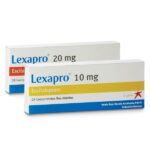How Does Lexapro Make You Feel The First Week?

What is Lexapro?
Lexapro is a brand of escitalopram a prescription drug that is available as an oral tablet and an oral liquid solution. It’s approved for use in adults and children 12 years and older. The medication belongs to the class of drugs called selective serotonin reuptake inhibitors (SSRIs). Lexapro works by increasing the amount of the chemical serotonin in your brain. Having more serotonin helps decrease the symptoms of depression and anxiety.
Lexapro is not considered a monoamine oxidase inhibitor (MAOI). MAOIs work by slowing down the breakdown of serotonin and dopamine, another chemical in your brain. This also helps alleviate symptoms of depression. However, MAOIs have a higher risk of side effects and drug interactions than SSRIs such as Lexapro.
How should Lexapro be used?
Escitalopram comes as a tablet and a solution (liquid) to take by mouth. It is usually taken once a day with or without food. To help you remember to take Lexapro, take it at around the same time every day, in the morning or in the evening.
Adult Dosage (ages 18 years to 64 years)
The usual dose is 10–20 mg, taken once per day.
Child Dosage (ages 12 to 17 years)
Usual dose: 10 to 20 mg once per day.
Child Dosage (ages 0 to 11 years)
It hasn’t been confirmed that this drug is safe and effective in people younger than 12 years.
Senior dosage (ages 65 years and older)
- The liver of older adults may not work as well as it used to. This can cause your body to process drugs more slowly. As a result, more of a drug stays in your body for a longer time. This increases your risk of side effects.
- Your doctor may start you on a lowered dose or a different medication schedule. This can help keep levels of this drug from building up too much in your body.
- The recommended dose is 10 mg, taken once per day.
Follow the directions on your prescription label carefully, and ask your doctor or pharmacist to explain any part you do not understand. Take Lexapro exactly as directed. Do not take more or less of it or take it more often than prescribed by your doctor.
Your doctor may start you on a low dose of Lexapro and increase your dose after 1 week.
It may take 1 to 4 weeks or longer before you feel the full benefit of Lexapro. Continue to take Lexapro even if you feel well. Do not stop taking Lexapro without talking to your doctor. Your doctor will probably decrease your dose gradually. If you suddenly stop taking Lexapro, you may experience withdrawal symptoms such as mood changes, irritability, agitation, nausea, dizziness, burning, numbness, or tingling in the hands or feet, anxiety, confusion, headache, sweating, shaking, frenzied or abnormally excited mood, tiredness, and difficulty falling asleep or staying asleep. Tell your doctor if you experience any of these symptoms while you are decreasing your dose of Lexapro or soon after you stop taking Lexapro.
What does it feel like when Lexapro starts working?
When Lexapro starts working, sleep, energy, or appetite may show some improvement within the first 1-2 weeks. Improvement in these physical symptoms can be an important early signal that the medication is working. Depressed mood and lack of interest in activities may need up to 6-8 weeks to fully improve.
Prior to starting Lexapro for anxiety or depression, tell your doctor if you are allergic or hypersensitive to escitalopram or if you are pregnant or breastfeeding. Also alert your doctor if you have a history of any of the following medical conditions, which may be exacerbated by Lexapro:
• Bipolar disorder
• Glaucoma
• Low salt levels (hyponatremia)
• Seizures
• Suicidal thoughts or behaviors
Tell your doctor about all medications, supplements, and vitamins that you currently take. While some drugs pose minor interaction risks, others may cause outright harm or prompt more careful consideration as to whether the pros of treatment outweigh the cons in your case.
How Does Lexapro Make You Feel The First Week?
When you start taking Lexapro, the first week may be characterized by improvement in energy levels, maintenance of focus, and improvement in the feeling of lack of concentration, guilt, or worthlessness. However, for some people, the early days of treatment may cause an increase in the levels of fear and anxiety and even suicidal thinking in some younger people. As a result, patients may stop using the treatment after a few weeks.
How long does it take to adjust to Lexapro?
For most people, adjusting to Lexapro can take up to 12 weeks for mood changes to improve. While taking Lexapro, it’s also possible to have side effects before you see an improvement in your mood. If you have side effects, be sure to talk to your doctor to see if you should continue and try another SSRI.
What are the possible side effects of Lexapro?
Get emergency medical help if you have signs of an allergic reaction: skin rash or hives; difficulty breathing; swelling of your face, lips, tongue, or throat.
Report any new or worsening symptoms to your doctor, such as mood or behavior changes, anxiety, panic attacks, trouble sleeping, or if you feel impulsive, irritable, agitated, hostile, aggressive, restless, hyperactive (mentally or physically), more depressed, or have thoughts about suicide or hurting yourself.
Call your doctor at once if you have:
• blurred vision, tunnel vision, eye pain or swelling, or seeing halos around lights;
• racing thoughts, unusual risk-taking behavior, feelings of extreme happiness or sadness;
• pain or burning when you urinate;
• (in a child taking Lexapro) slow growth or weight gain;
• low levels of sodium in the body –headache, confusion, slurred speech, severe weakness, vomiting, loss of coordination, feeling unsteady; or
• severe nervous system reaction –very stiff (rigid) muscles, high fever, sweating, confusion, fast or uneven heartbeats, tremors, feeling like you might pass out.
Seek medical attention right away if you have symptoms of serotonin syndrome, such as agitation, hallucinations, fever, sweating, shivering, fast heart rate, muscle stiffness, twitching, loss of coordination, nausea, vomiting, or diarrhea.
Common side effects may include:
• painful urination;
• dizziness, drowsiness, tiredness, weakness;
• feeling anxious or agitated;
• increased muscle movements, feeling shaky;
• sleep problems (insomnia);
• sweating, dry mouth, increased thirst, loss of appetite;
• nausea, constipation;
• yawning;
• nosebleed, heavy menstrual periods; or
• decreased sex drive, impotence, or difficulty having an orgasm.
This is not a complete list of side effects and others may occur. Call your doctor for medical advice about side effects. You may report side effects to FDA at 1-800-FDA-1088.
What should I avoid while taking Lexapro?
Ask your doctor before taking a nonsteroidal anti-inflammatory drug (NSAID) such as aspirin, ibuprofen (Advil, Motrin), naproxen (Aleve), celecoxib (Celebrex), diclofenac, indomethacin, meloxicam, and others. Using an NSAID with Lexapro may cause you to bruise or bleed easily.
Avoid alcohol.
Avoid driving or hazardous activity until you know how this medicine will affect you. Your reactions could be impaired.





